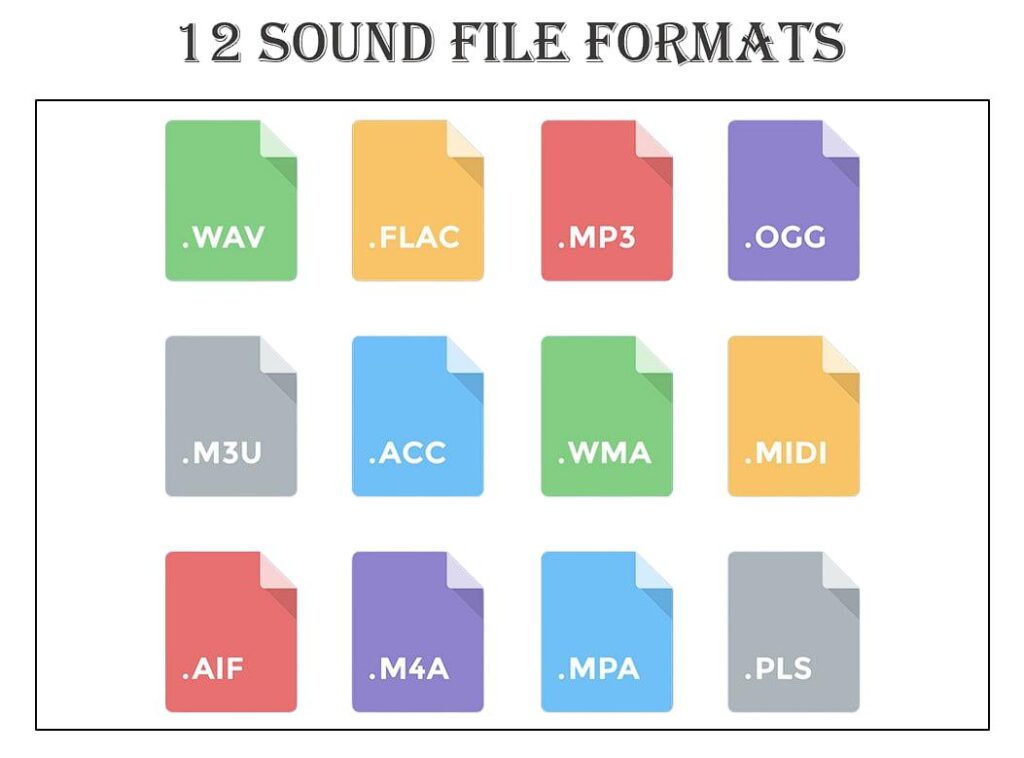Here is some of my work with sound:
Audacity app
The task was to combine 3 sounds into one and make the sound more cohesive. The “Audacity” application was used. Here are the modifications made to the sound:
Read more
In the world of music,
there are many music formats, their modifications, and versions, created by giants in the music industry and smaller companies, which have gained worldwide recognition in the electronic music realm.
For these purposes, various physical methods for storing audio data were designed, such as vinyl records, magnetic tape, CDs, DAT, MD, and DVDs. Similarly, numerous digital methods for storing audio data have emerged, including formats like OGG, MP3, FLAC, and WAV. Additionally, there are methods for converting sheet music into music formats like MIDI.
The first audio file format: WMA (Windows Media Audio)
- WMA is a Microsoft-developed audio format, aiming to compete with MP3.
- WMA has evolved and now includes advanced lossless audio encoding algorithms.
- WMA can also contain video data, making it versatile.
- WMA files are commonly recognized by the extensions .wma and .asf.
WAV – Microsoft Wave
- They usually store audio in mono or stereo with a 44.1 kHz sampling frequency and 8 or 16 bits per sample.
- WAV is favored for its lossless audio quality and is popular in professional audio and high-quality audio recordings.
- WAV files don’t use compression, ensuring excellent audio quality.
APE (Monkey’s Audio)
- APE – a lossless digital audio format.
- The Monkey’s Audio codec is officially available for Windows, but unofficial versions exist for MacOS, Linux, and BeOS.
- File extensions: .ape for audio and .apl for metadata.
- This format is not open due to licensing restrictions that limit its distribution.

MOD
- The MOD format was developed for the Amiga platform.
- Each MOD file contains digitized recordings of real instruments, known as samples, and has a structure similar to MIDI.
- A composer using the MOD format works with a tracker program, specifying which instruments should play, when to play them, and which notes and octaves to use. This sequence of notes is recorded in a list called a “track,” and several parallel tracks form a block known as a “pattern.”
- A collection of patterns makes up a module – a file in the MOD format with the extension .mod.
- Each row in the tracker corresponds to one real channel where the composer can play or edit the numbered notes.
- Notes can be assigned various “ornaments,” such as tremolo, glissando, and others.
MP3
- MP3 (MPEG Layer 3) is the most popular digital music encoding format, but is not considered a professional format in terms of technical parameters.
- MP3 is a lossy compression format, where a portion of the audio data, determined by psychoacoustic models, is discarded and cannot be recovered.
- The quality of MP3 depends on the bitrate and the codec used.
- Many people prefer a bitrate of 320 kbps or higher-quality formats like FLAC (with an average bitrate of around 1000 kbps).
- Professional musicians and DJs use tracks with a bit rate of no less than 320 kbps.
MIDI
- MIDI stores commands, not digital sound: notes, instruments, and parameters.
- Convenient for chord-based arrangements.
- Smaller-sized MIDI files.
- Universal, and information that is not understood by other applications is simply ignored.
- Midi-minus-vocals save information about instruments, tempo, key, and other parameters.
FLAC
- FLAC – Free Lossless Audio Codec, is a lossless compression format.
- It retains all audio data, making it suitable for Hi-Fi, Hi-End audio equipment, and archiving.
- It’s supported by many audio players and applications.
- FLAC uses ID3v1 and ID3v2 tags to store metadata, which can be edited.
DTS
- DTS – Digital Theater System, a competitor to Dolby Digital.
- DTS uses minimal compression compared to Dolby, which results in better sound quality, as seen in practice on DVD discs.
- In home theaters, DTS can use a maximum bitrate of 1,536 kbps (full bitrate), providing higher sound quality than Dolby Digital’s AC-3 format.
- DTS utilizes 6 discrete audio tracks and supports a 7.1 sound distribution system. At a bitrate of 1,536 kbps, DTS 4.0 delivers the same immersive experience as Dolby 5.1.
Audio file format: AIFF
- AIFF – an audio data format for Apple Macintosh.
- It supports 8- and 16-bit mono and stereo files.
- AIFF files can contain a Mac-Binary header, in which case they will have the extension .snd.
- Files with the .snd extension can be played using the Sound Forge program.
- However, Sound Forge may recognize them as the Macintosh Resource format, though it won’t affect the sound quality.
The final audio file format: AAC (Advanced Audio Coding)
- AAC – an audio file format with less loss in quality compared to MP3 at a similar file size.
- There’s an ALAC profile for encoding music without loss in quality.
- AAC belongs to the MPEG-4 family of audio encoding algorithms.
- Unlike MP3, which uses a hybrid filter bank, AAC uses MDST (Modified Discrete Sine Transform) technology, providing higher sound quality at the same or lower bitrates.
- File extensions for AAC can be .m4a, .m4b, and .m4p.

